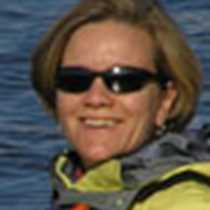Discovery Islands
They call this region of British Columbia “The Sunshine Coast”, and today we certainly understood why. This morning, we stepped on deck with mugs of steaming coffee to marvel at the gorgeous sunrise and glassy calm seas in the Strait of Georgia. With Vancouver Island to the west, and the peaks of the Coast Range to the east, we watched tiny, isolated Mitlenatch Island grow larger on the horizon. This 88-acre island was designated the first Nature Park in British Columbia in 1960, and provides nesting habitat for nearly 2,800 pairs of glaucous-winged gulls, as well as hundreds of pelagic cormorants. Although most of the gulls had completed their breeding season and their chicks had fledged, we were thrilled to find many other island inhabitants. Dozens of pelagic cormorants perched on steep cliff faces, a few still tending chicks on the nest! Hundreds of harbor seals surrounded the island, either hauled out on rocks or craning their necks for a better view of their colorfully clad visitors. Black oystercatchers, with their long red bills, foraged in the exposed intertidal zone. Just below the tide line, we saw dozens of bright purple seastars, red urchins and mottled red and gray leather stars. The variety and quantity of life was astounding.
After lunch, and a few hours cruising, we arrived at our afternoon’s anchorage at Roscoe Bay Marine Park, located at the southeastern corner of West Redonda Island. Here, we launched kayaks for a serene paddle around this long, narrow bay, finding huge clusters of moon jellies below us and golden big leaf maples dotting the hillside above. Hikers walked a short, gentle path to Black Lake, with some continuing on a rockier trail along the lake’s margin. The sunshine worked its magic, enticing the young and young-at-heart to bathe, both in cool salt water and warm lake water. What a day!
They call this region of British Columbia “The Sunshine Coast”, and today we certainly understood why. This morning, we stepped on deck with mugs of steaming coffee to marvel at the gorgeous sunrise and glassy calm seas in the Strait of Georgia. With Vancouver Island to the west, and the peaks of the Coast Range to the east, we watched tiny, isolated Mitlenatch Island grow larger on the horizon. This 88-acre island was designated the first Nature Park in British Columbia in 1960, and provides nesting habitat for nearly 2,800 pairs of glaucous-winged gulls, as well as hundreds of pelagic cormorants. Although most of the gulls had completed their breeding season and their chicks had fledged, we were thrilled to find many other island inhabitants. Dozens of pelagic cormorants perched on steep cliff faces, a few still tending chicks on the nest! Hundreds of harbor seals surrounded the island, either hauled out on rocks or craning their necks for a better view of their colorfully clad visitors. Black oystercatchers, with their long red bills, foraged in the exposed intertidal zone. Just below the tide line, we saw dozens of bright purple seastars, red urchins and mottled red and gray leather stars. The variety and quantity of life was astounding.
After lunch, and a few hours cruising, we arrived at our afternoon’s anchorage at Roscoe Bay Marine Park, located at the southeastern corner of West Redonda Island. Here, we launched kayaks for a serene paddle around this long, narrow bay, finding huge clusters of moon jellies below us and golden big leaf maples dotting the hillside above. Hikers walked a short, gentle path to Black Lake, with some continuing on a rockier trail along the lake’s margin. The sunshine worked its magic, enticing the young and young-at-heart to bathe, both in cool salt water and warm lake water. What a day!




